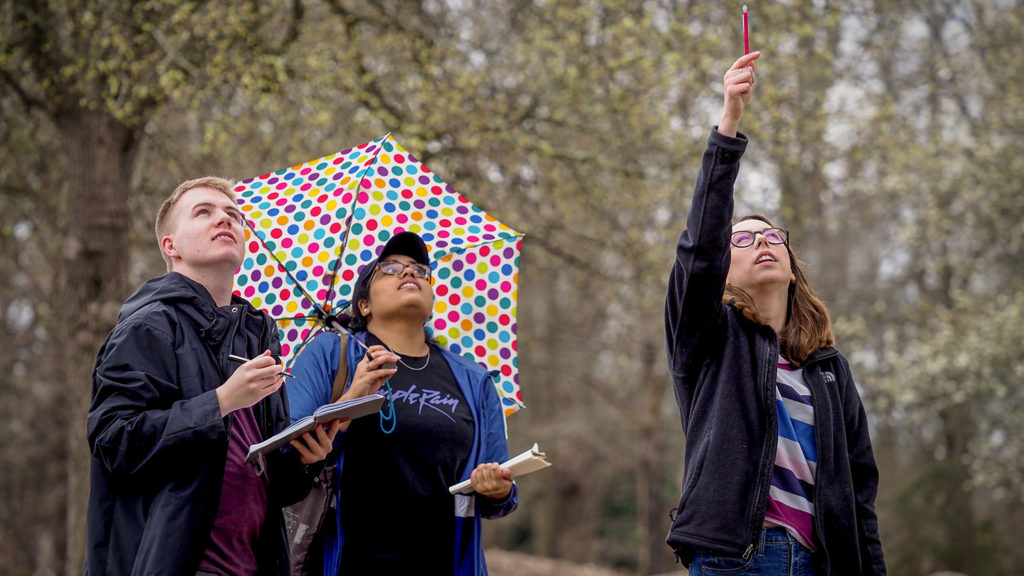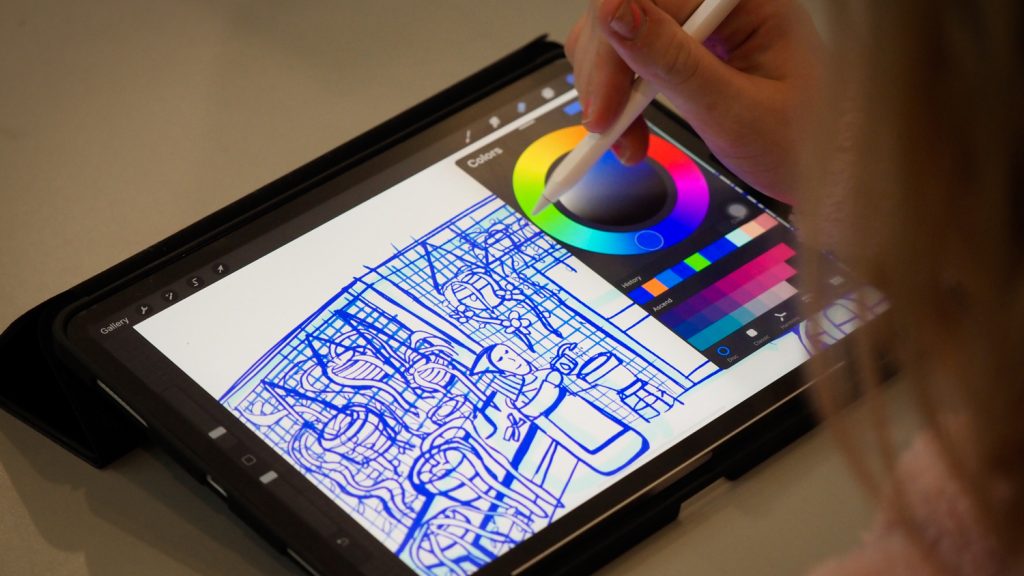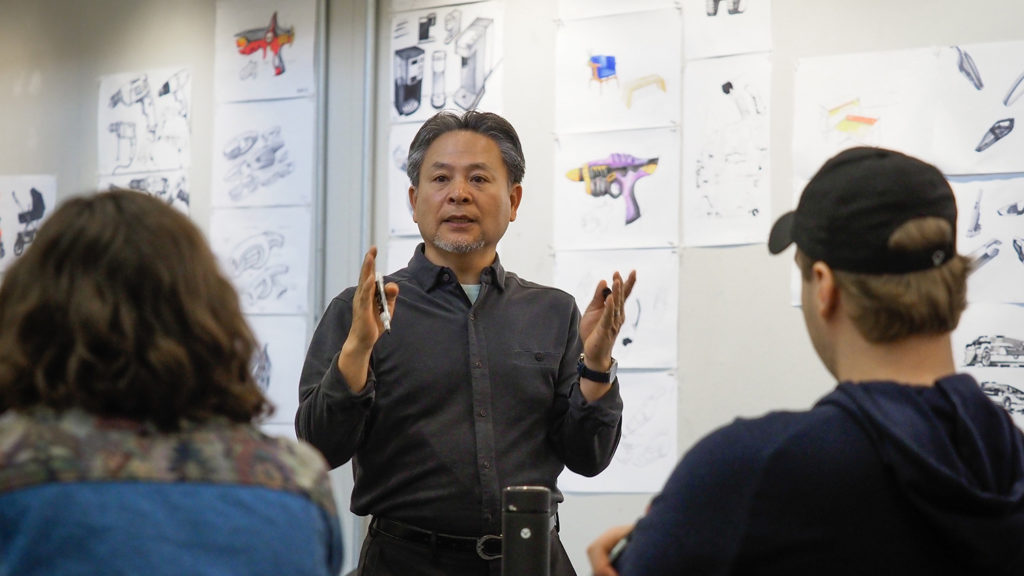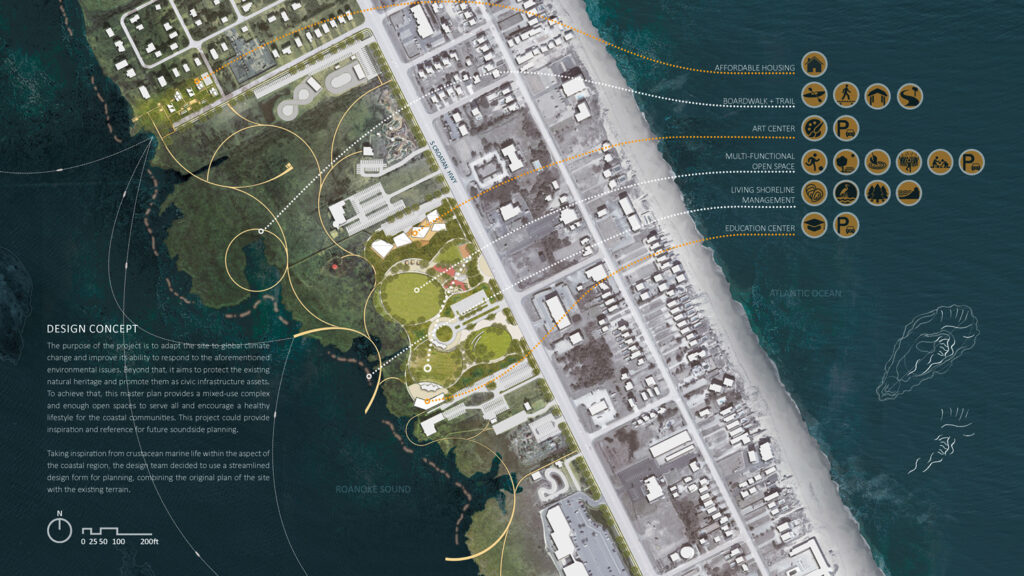Explore Graduate Majors
Take a closer look at background criteria, research areas, faculty expertise and available student support for our graduate degrees in Architecture, Media Arts, Design and Technology, Graphic & Experience Design, Industrial Design and Landscape Architecture and Environmental Planning.
Architecture

Be a strong, positive force in the creation of healthy and sustainable buildings and communities.
Faculty Expertise and Research Areas
Faculty expertise:
- Energy and Technology
- Public Interest Design
- History and Theory
- Design and Build
- Coastal Dynamics
- Health and Sustainability
Research areas:
- Energy and Technology
- Public Interest Design
- History and Theory
- Design and Build
- Coastal Dynamics
- Health and Sustainability
Academic Criteria and Degree Options
Academic background criteria:
Track 1: Applicants are required to have a degree in architecture from a program that has a NAAB-accredited degree. This program typically takes four semesters to complete.
Track 2: Applicants are required to have a Bachelor of Architecture degree (B.Arch) from a NAAB-accredited institution. This program typically takes three semesters to complete.
Track 3: Applicants are required to have a bachelor’s degree in subjects other than architecture. This program typically takes seven semesters to complete.
Degree options:
Graduate Student Support
Graduate student support:
A limited number of fellowships, scholarships, and Graduate Student Support Plans (GSSP) are available for incoming students. For new applicants to the program, we award fellowships, scholarships, and GSSP based on a review of information in the application (no additional materials are required). Continuing students are considered for merit-based fellowships, scholarships, and GSSP based on academic accomplishments.
Teaching Assistantships (TA) are selected based on faculty needs and student capabilities. Applicants can indicate interest in TA positions, areas of interest, and special skills in the application’s personal statement. Continuing students may apply to be a TA.
Media Arts, Design and Technology

Find new intersections in interactive and emergent media through experimentation and by exploring the impact and potentials of creative technologies on culture and society.
Faculty Expertise and Research Areas
Faculty expertise:
- Mixed and Virtual reality
- Gaming and Gamification
- 2D and 3D animation
- Machine Learning and Artificial Intelligence
- Computational Media Research
- Human-Computer Interaction, UX/UI
- Experimental Interactive Art and Media
- Visual Narrative
- Mapping and Visualization
- Reactive Environments
- Open Source Design
- Digital Fabrication
- Drawing and Painting, Illustration
- Documentary Filmmaking
- Electronics
- Photography
- Music Composition
- Music Theory
- Storytelling
- Interactive installation
- Kinetic and Mechatronic Interactions
- Wearable Technologies
Research areas:
- Traditional Chinese ink wash painting using virtual reality
- Audible and visual study in reactive spaces
- Storytelling as a nonverbal Narrative conveyed through acting, music, and sound
- Sonic narrative
- Virtual reality study in the digital humanities
- Interactive demonstration of solar power
- Disseminating narrative as branded entertainment utilizing 3D animation
- Suspension of disbelief through personal struggle in hybrid media
- Activity based conceptual learning
- Interactive experiences to enhance storytelling and learning in public spaces
- Mycological applications in Art and Design
- Embodying the inner critic
- Commercialization of religion
Academic Criteria and Degree Options
Academic background criteria:
Track 2: For students with undergraduate degrees in art and design or fields closely related to their concentration area. Track 2 students have some accomplishments and/or strong work experience within their chosen concentration area. Track 2 students may take some advanced undergraduate courses to further their conceptual, theoretical and technical acumen within their chosen concentration.
Track 3: For applicants with undergraduate degrees related to the concentration area or some experience working within their chosen concentration area. Once in the program, all Track 3 students will take 2 semesters of undergraduate work in the concentration (21-24 credit hours) to improve skills, experiment, and gain confidence in the medium.
Degree options:
Graduate Student Support
Graduate student support:
We offer a variety of opportunities for Graduate students to TA in undergraduate courses, including the First Year Experience Studio, Design Thinking, Basic Drawing, 2D-Design. In addition, faculty offer additional Research Assistant opportunities as projects and funding allows. Students are not automatically guaranteed a TA or RA position in their first year, but we work hard to fill positions, especially if a particular interest of the student.
Graphic & Experience Design

Move toward a deeper knowledge of graphic & experience design and more purposeful, individually driven design practices. Student inquiry into contemporary and emergent design issues prepares graduates for leadership positions that evolve the profession and advance the discipline.
Faculty Expertise and Research Areas
Faculty expertise:
- Graphic design practices
- Graphic design and typographic history
- Graphic design and typographic theory
- Graphic design and ornamentation
- Visual metaphor and narrative
- Typography
- User-centered design research methods
- User-centered interaction and engagement
- Participatory design and community engagement
- Interdisciplinary collaboration
- Inclusive Design
- Visual communication and emerging technology (VR/AR)
- Tactile coding environments
- Computational thinking in design
- Visual programming languages
- 2D, 3D, 4D interface strategies
- Games and play systems
- Design-based teaching and learning
Research areas:
Students identify their own areas of interest that reflect timely design issues. Recent topics have included:
- “Visuospatial Strategies for Novice Fiction Writers”
- “Learning the Traditional Lakota Visual Language Through Shape Play”
- “Building Upon Interaction Gestalt Research”
- “Chinese Style Variable Roman Letterform Design”
- “Cross-Device Tracking Toward Successful Recovery From Physical Injury”
- “Digital Map Interactions to Support Long-Term Decision Making About Choosing a Neighborhood”
- “A Gamified System to Encourage Healthy Eating for College Males”
- “Extending and Enhancing Meaningful Conversation”
Academic Criteria and Degree Options
Academic background criteria:
Track 2:
The MGXD II program targets applicants who have earned a BFA or equivalent in graphic design and are practiced in visual communication, interaction design, and related design fields.
Integrated graduate studios, seminars, and workshops expose students to histories, design (and related) theories, and research methods that point to current and emerging practices. Students investigate questions individually and collaboratively around the design of communication and interaction in several ways: through making (visualizations, visual diagrams, and functioning prototypes, for instance); assigned and independent reading and research; discussion and critique; and writing. Students also enroll in at least one elective offered in the college, university, or our affiliate universities, Duke University and UNC, Chapel Hill.
Students create a body of work as they explore research interest areas within studio and seminar subtopics. The experience of creating this work, coupled with researching and writing, positions students to identify a specific design investigation in their final year, which culminates in the required Final Project. For this work, students comprehensively research an area of interest, design propositional artifacts (findings), document the research and findings in a written thesis, and present the project in a public forum.
Track 3:
The MGXD III program targets applicants who have some professional experience but who have not earned a first degree in graphic design or have earned a BA with a graphic design concentration.
Students enroll in two semesters of specialized and advanced undergraduate coursework prior to matriculating to the MGXD II program. The curriculum is comprised of six studio-based courses and at least two lecture/seminar courses. Six credit studios cover systems design for user experience, visual communication, branding, service design, and other distinct graphic design topics. Additional three-credit studio courses focus on subjects such as mobile interaction, typography, and coding for interaction design.
Degree options:
Graduate Student Support
Graduate student support:
The Department of Graphic Design has limited funds to assist students in paying for the cost of their education. Some students may apply for, and be offered, TA or RA positions on a semester by semester basis, determined by departmental need and student experience. The relatively low NC State tuition (and, for non-residential students, North Carolina residency laws that recognize graduate students as residents after their first year) usually makes the cost of attending NC State well below that of other graduate institutions.
Industrial Design

Study human physical and cognitive interaction with artifacts and services in order to discover user experience insights and then create innovative solutions to design problems.
Faculty Expertise and Research Areas
Faculty expertise:
- Design for service and social innovation
- Design history
- Design thinking and design strategy
- Entrepreneurship
- Human-centered design research
- Industry and interdisciplinary collaborations
- Materials and manufacturing processes
- Medical device development
- Transportation design
- Universal design
Research areas:
- Industry and interdisciplinary collaborations
- Human-centered design
- Design for healthcare
- Serious games
Academic Criteria and Degree Options
Academic background criteria:
Track 2: This graduate-level program is designed for individuals with an undergraduate degree in industrial design. A 2-year program centered around studios, the final project is selected and developed by the graduate student based on their interests.
Track 3: This graduate-level program is designed for individuals without an undergraduate degree in industrial design. A 3-year program with the first year focused on skill development, the program is centered around studios culminating in a final project selected and developed by the graduate student based on their interests.
Degree options:
Graduate Student Support
Graduate student support:
The Department of Industrial Design has limited funds to assist students in paying for the cost of their education. The low tuition and liberal requirements for US citizens to establish North Carolina residency (thus reducing the second-year tuition to the in-state rate) usually makes attending NC State well below the cost of a comparable education in other institutions. Decisions about assistantships are made on the basis of the match between student skills and departmental needs. Scholarships and external merit awards are also available.
Landscape Architecture and Environmental Planning

Create innovative and resilient landscape solutions focused on human and ecosystem health, safety and wellbeing.
Faculty Expertise and Research Areas
Faculty expertise:
- Site planning and design inquiries
- Geographic information systems and predictive modeling
- Environmental justice
- Coastal communities and ecosystems
- Low impact design strategies
- Traditional language of design
- Design thinking
- Comprehensive community design and engagement
- Construction detailing, implementation and materials
- Horticulture and design
- Outdoor environments in relation to child development and health outcomes
- Landscape performance and evidence-based design
- Public practice and process
- Land use and planning
- Environmental protection and resilience
- Energy conservation
- Graphic applications and digital media
- Greenways and trail systems
Research areas:
- Site planning and design inquiries
- Geographic information systems and predictive modeling
- Environmental justice
- Coastal communities and ecosystems
- Low impact design strategies
- Traditional language of design
- Design thinking
- Comprehensive community design and engagement
- Construction detailing, implementation and materials
- Horticulture and design
- Outdoor environments in relation to child development and health outcomes
- Landscape performance and evidence-based design
- Public practice and process
- Land use and planning
- Environmental protection and resilience
- Energy conservation
- Graphic applications and digital media
- Greenways and trail systems
Academic Criteria and Degree Options
Academic background criteria:
First professional Master of Landscape Architecture program: For students who do not have an BA in Landscape Architecture from an accredited university.
Post-professional, 48-credit-hour Master of Landscape Architecture program: For students who have an accredited degree from a landscape architecture program.
Post-professional, 30-credit-hour Master of Landscape Architecture program: For students who have an accredited degree from a landscape architecture program and are CLARB registered.
Degree options:
- First professional Master of Landscape Architecture
- Post-professional Master of Landscape Architecture
- Inter-Institutional Study: Concurrent degrees from the NCSU Department of Landscape Architecture and UNC-Chapel Hill’s Department of City and Regional Planning
- Graduate minor
- Graduate Certificate in Geospatial Information Systems
- Graduate Certificate in Public Policy
- Graduate Certificate in Horticultural Science
- Graduate Certificate in City Design
Graduate Student Support
Graduate student support:
- RA/TA opportunities – GSSP and hourly positions
- Scholarships
- Fellowships